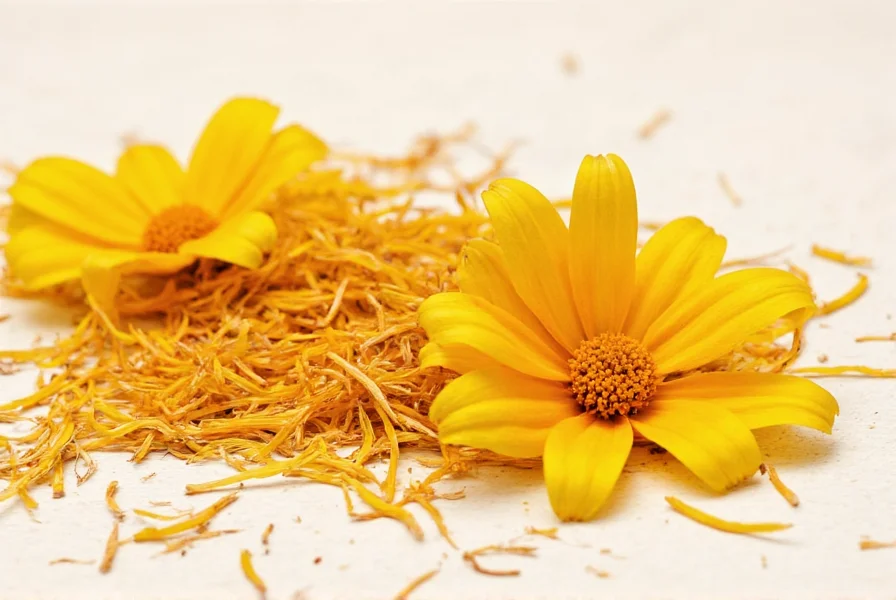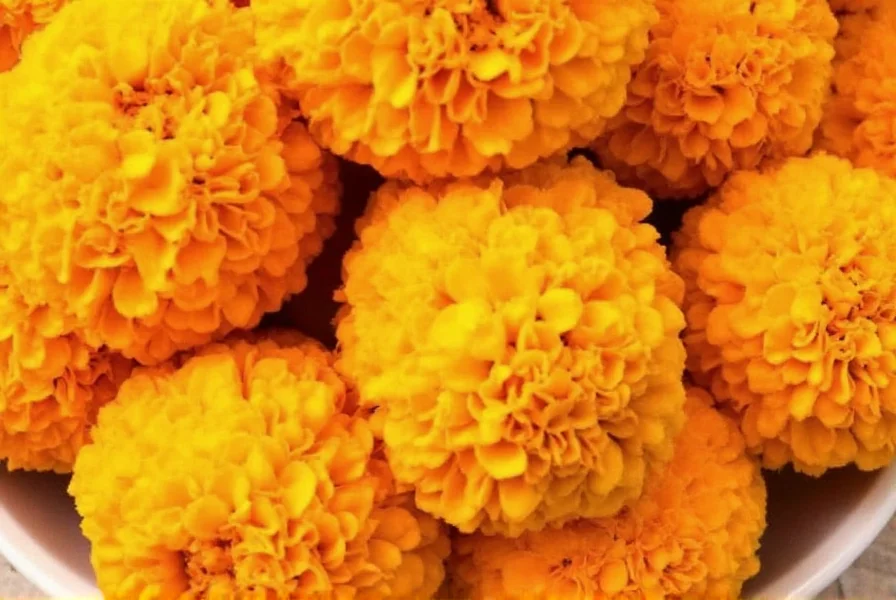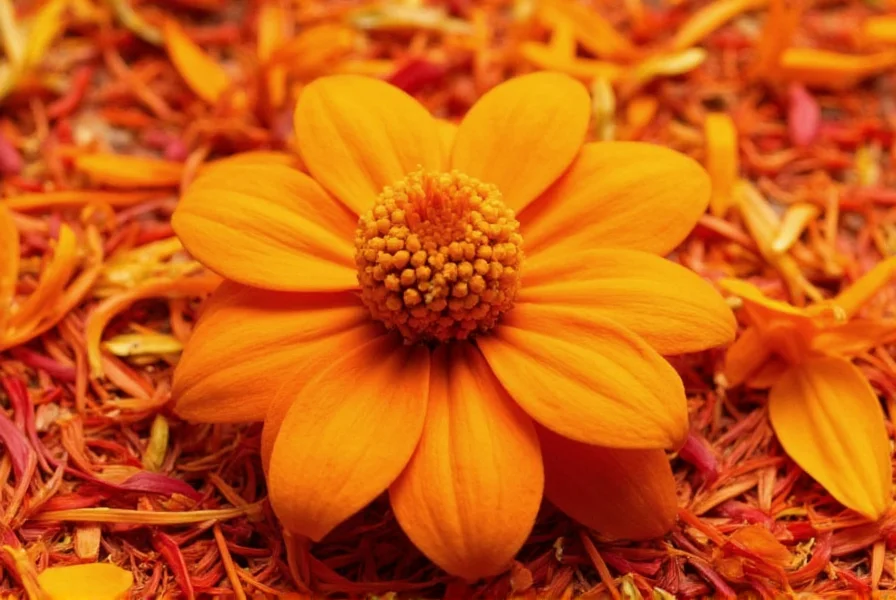Saffron marigold, scientifically known as Tagetes erecta, often causes confusion in gardening and culinary circles due to its misleading name. This vibrant flowering plant belongs to the Asteraceae family and is native to Mexico and Central America. Unlike true saffron—which requires painstaking hand-harvesting of Crocus sativus stigmas—saffron marigold produces abundant, daisy-like flowers that bloom profusely throughout warm seasons.
Botanical Characteristics and Identification
Saffron marigold features sturdy, branching stems that typically grow 1-3 feet tall, with pinnately divided leaves emitting a distinctive scent when crushed. The flowers range from golden yellow to deep orange, with double or semi-double forms being most common in cultivation. Each flower head contains both ray florets (the visible 'petals') and disk florets (the center portion).
Key identifying features include:
- Flower diameter of 2-4 inches
- Strong, somewhat pungent aroma
- Dark green, fern-like foliage
- Blooming period from late spring through first frost
| Characteristic | Saffron Marigold (Tagetes erecta) | True Saffron (Crocus sativus) |
|---|---|---|
| Plant Type | Annual flowering plant | Corm-producing perennial |
| Family | Asteraceae (daisy family) | Iridaceae (iris family) |
| Active Compounds | Lutein, zeaxanthin | Crocin, picrocrocin, safranal |
| Culinary Value | Colorant only (no saffron flavor) | Distinct flavor, aroma, color |
| Production Cost | Low (easy to grow) | Extremely high (labor-intensive) |
Growing Saffron Marigold Successfully
Cultivating saffron marigold requires minimal expertise, making it accessible for beginner gardeners. These plants thrive in full sun with well-draining soil and moderate watering. Unlike true saffron crocus, which requires specific climate conditions, saffron marigolds adapt to various growing zones as annuals.
For optimal growth:
- Plant seeds after last frost when soil reaches 65°F (18°C)
- Space plants 8-12 inches apart for adequate air circulation
- Deadhead spent blooms to encourage continuous flowering
- Avoid overwatering, which can lead to root rot
Commercial growers often cultivate saffron marigold specifically for lutein extraction, a carotenoid used in food coloring and nutritional supplements. The petals contain high concentrations of this pigment, making them valuable for natural colorant production.

Practical Applications of Saffron Marigold
While saffron marigold cannot replicate the unique flavor profile of genuine saffron, it serves several valuable purposes:
Culinary Uses
In some traditional cuisines, particularly in parts of Africa and Asia, dried saffron marigold petals function as a colorant in rice dishes, soups, and baked goods. The petals provide visual similarity to saffron without the distinctive taste. Chefs seeking authentic saffron flavor should note that saffron marigold cannot substitute for true saffron's complex aroma and taste.
Natural Dye Production
The high lutein content makes saffron marigold an excellent source for natural yellow and orange dyes. Textile artisans value these flowers for creating vibrant, non-toxic colorants. The dyeing process involves boiling petals to extract pigments, then treating fabric with mordants to set the color.
Medicinal and Cultural Significance
Traditional medicine systems have employed saffron marigold for various purposes, though scientific evidence remains limited. Some cultures use the flowers in ceremonial decorations and religious offerings. The plant's strong scent also makes it effective as a companion plant that deters certain garden pests.

Addressing Common Misconceptions
The most persistent myth surrounding saffron marigold is that it serves as a direct substitute for saffron in cooking. While both provide yellow coloring, saffron marigold lacks crocin (the compound responsible for saffron's distinctive flavor and aroma). Calling saffron marigold 'Mexican saffron' or 'American saffron' creates unnecessary confusion in culinary contexts.
Another misconception involves medicinal claims. While saffron marigold contains beneficial carotenoids, it shouldn't be considered equivalent to true saffron, which has been studied for potential mood and cognitive benefits. Consumers should approach exaggerated health claims about saffron marigold with appropriate skepticism.
Harvesting and Processing Tips
For those interested in using saffron marigold as a colorant, proper harvesting technique affects quality:
- Collect flowers in mid-morning after dew has evaporated
- Select fully opened blooms at peak color intensity
- Remove petals from the flower base (the green portion can impart bitterness)
- Dry petals away from direct sunlight to preserve color
- Store dried petals in airtight containers away from light
When using saffron marigold in cooking, add the petals early in the cooking process to allow sufficient time for color extraction. Unlike true saffron threads, which require steeping, marigold petals benefit from direct heat to release their pigments.
Frequently Asked Questions
Can saffron marigold replace saffron in recipes?
Saffron marigold can provide similar yellow coloring but cannot replicate saffron's distinctive flavor and aroma. It serves as a visual substitute only in dishes where color matters more than authentic saffron taste.
Is saffron marigold safe to consume?
Yes, saffron marigold petals are generally recognized as safe for consumption in culinary amounts. However, some individuals may experience allergic reactions, particularly those sensitive to plants in the Asteraceae family.
How do I grow saffron marigold from seed?
Sow saffron marigold seeds directly in garden soil after last frost, planting ¼ inch deep. Keep soil moist until germination (5-7 days), then water when top inch of soil feels dry. Plants typically flower 8-10 weeks after planting.
What's the difference between French and African marigolds?
Saffron marigold (Tagetes erecta) is often called African marigold, though it originated in the Americas. French marigolds (Tagetes patula) are smaller plants with more finely divided leaves and smaller flowers. Both types belong to the same genus but have distinct growth habits and flower forms.
Why is saffron marigold used in natural dye production?
Saffron marigold contains high concentrations of lutein, a carotenoid pigment that produces vibrant yellow to orange colors. The flowers provide an accessible, non-toxic source of natural colorant that works well with various mordants to create lightfast dyes for textiles.











 浙公网安备
33010002000092号
浙公网安备
33010002000092号 浙B2-20120091-4
浙B2-20120091-4